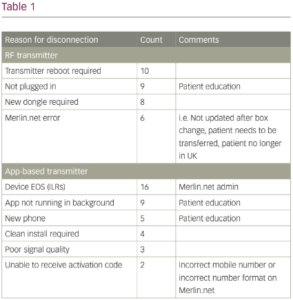Background: Remote monitoring (RM) for implanted cardiac devices continues to increase nationally. Ensuring patient RMs maintain connectivity is key to patient safety and service delivery. At a large tertiary centre with over 7,000 patients enrolled on RM, management of patients with disconnected remote monitors is challenging. We collaborated with industry and piloted a new disconnected patient service provided by Abbott.
Aim: The aim was to reduce the number of disconnected patients enrolled on Merlin.net and to identify common reasons and themes for disconnection.
Method: The industry team were provided with read-only login details for Merlin.net. Disconnected patient lists were reviewed on a monthly basis, with disconnected patients directly contacted by the industry team by telephone to support re-connection. A maximum of three call attempts were made. Where patients were non-contactable a voicemail was left requesting a call back. Patient education and troubleshooting was provided to contactable patients. Calls made, reasons for disconnection and comments requesting advice on how to proceed were provided to the Bart’s Heart Centre team following attempts to contact all patients. Returned lists and data received were analysed by the Bart’s team to support further patient management.
Results: The percentage of patients with disconnected monitors as a total of all patients enrolled reduced by 5.1% (190 to 120 patients) during the 10-week pilot study: 68 patients (36%) were reconnected following a phone call; 23 patients (12%) were contacted and required further troubleshooting; 25 patients (13%) reconnected spontaneously without the need for a call; 35 patients (18%) were non-contactable; 30 patients (16%) had findings requiring the hospital team to action; 8 patients were identified as deceased; 1 patient was an inpatient. The most common reasons for radiofrequency (RF)- and App-based transmitter disconnections are displayed in Table 1.
Conclusion: Management of patients with disconnected remote monitors creates a significant time and resource burden. Collaborating with industry using a dedicated patient reconnection service has the potential to significantly reduce disconnected monitor numbers and provides a feedback mechanism to support development of RM services. Common themes for disconnection need addressing through better delivery of patient education considering transmitter type, by developing processes to ensure patient contact details and preferred contact methods are recorded, and by improving administrative processes to minimise errors in data entry at enrolment.
Acknowledgements: Thank you to Susana Drake and Jess Panchal at Abbott for their work and support on this project.








